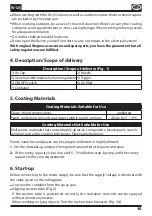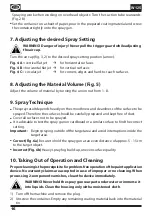
16
W 125
GB
Spraying work when working on overhead objects: Turn the suction tube rearwards.
(Fig. 2 B)
•
Set the container on a sheet of paper, pour in the prepared coating material and screw
the container tightly onto the spray gun.
7. Adjusting the desired Spray Setting
WARNING! Danger of injury! Never pull the trigger guard while adjusting
the air cap.
Turn the air cap (fig. 3, 2) to the desired spray setting position (arrow).
Fig. 4 A
= vertical flat jet
for horizontal surfaces
Fig. 4 B
= horizontal flat jet
for vertical surfaces
Fig. 4 C
= circular jet
for corners, edges and hard-to-reach surfaces
8. Adjusting the Material Volume (Fig. 5)
Adjust the volume of material by turning the union nut from 1 - 8.
9. Spray Technique
•
The spray result depends heavily on the smoothness and cleanliness of the surface to be
sprayed. Therefore the surface should be carefully prepared and kept free of dust.
•
Cover all surfaces not to be sprayed.
•
It is advisable to test the spray gun on cardboard or a similar surface to find the correct
setting.
Important:
Begin spraying outside of the target area and avoid interruptions inside the
target area.
•
Correct (Fig. 6a)
Be sure to hold the spray gun at an even distance of approx. 5 - 15 cm
to the target object.
•
Incorrect (Fig. 6b)
Heavy spray fog build-up, uneven surface quality.
10. Taking Out of Operation and Cleaning
Proper cleaning is the prerequisite for problem-free operation of the paint application
device. No warranty claims are accepted in case of improper or no cleaning. When
processing 2-component varnishes, clean the device immediately.
WARNING! Never hold the spray gun rear part under water or immerse it
into liquids. Clean the housing only with a moistened cloth.
1) Turn off the machine and remove the plug.
2) Unscrew the container. Empty any remaining coating material back into the material
tin.
















































